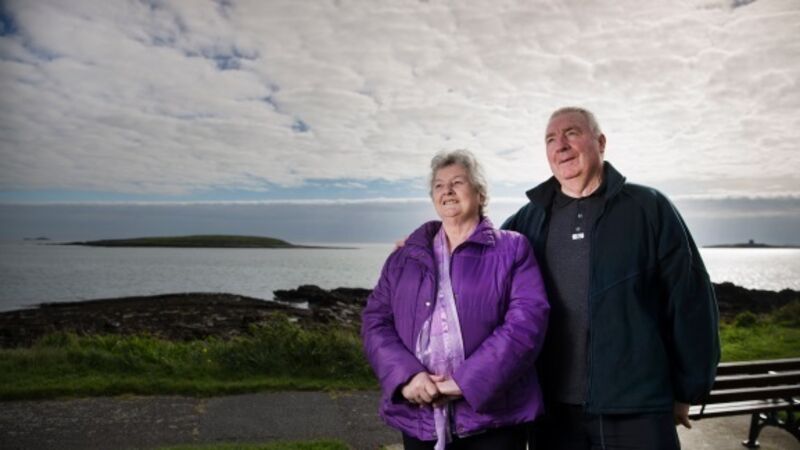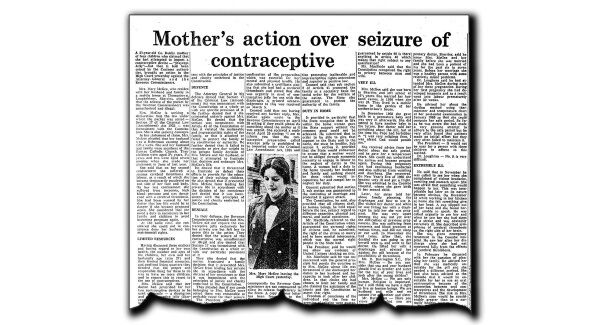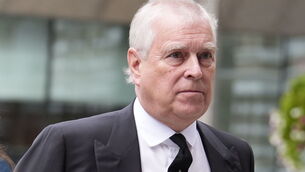How much has really changed for women’s sexual and reproductive rights in 40 years?

THE dates are indelibly marked on May McGee’s memory.
December 15, 1968, she became a mother for the first time with the birth of baby Martin; January 2, 1970, her second child, Gerard, was born; November 15, 1970, the arrival of the twins, Sharon and Sylvia.
“I had four babies in 23 months. Talk about being fertile,” she says. Her husband, Seamus, a fisherman at the time, shares a family joke: “I used to say if I came home and so much as took off my rubber boots, she’d get pregnant.”
They weren’t alone in facing the challenge of frequent births in the Ireland of almost half a century ago. With contraception illegal by the law of the land and immoral by the law of the Catholic Church, family planning required a mixture of ingenuity, brass neck, self restraint, and luck.
“I knew of a woman in Monaghan who had seven children under four,” May recalls. “She had one a year and then triplets. And I thought I had it hard.”
Actually, May did have it hard. She had pre-eclampsia and shingles on her first pregnancy and Martin was born six weeks early, so small she had to wait six weeks and two days to hold him.
The delivery was traumatic for May too and for two months afterwards, she struggled to walk. She wasn’t long recovered when she became pregnant again.
Early in her pregnancy she suffered what later was understood to have been an undetected stroke. A few months later, on New Year’s Eve, alone at home minding baby Gerard while Seamus was out working on a delivery run, she suffered another one.
“I lost the use of my arm. My arm just fell and it felt like everything was switched off. I knew I had to go for help.”
It took all her strength to get next door and raise the alarm and May was rushed to hospital, anxious that the speeding ambulance would bring on labour. She wasn’t due for another six weeks.
Her instinct proved right. “During the next night I suddenly woke up with an awful pain and I tried to reach for the little bell by the bed but I couldn’t get my arm moving.”
She laughs at the memory. “They only just reached the ward when the baby came. He popped out and I was still trying to tell them I was in labour.”
Baby Gerard was in hospital for three weeks and May began tests to try and establish what had happened to cause the strokes, but her main concern was that she not become pregnant again.
She went to her local GP, Dr James Loughran, to ask for the pill which was available at the time, but only for the purposes of regularising irregular menstrual cycles.
Not surprisingly, there was a minor epidemic of irregular cycles among Irish women who were lucky enough to hear of this rather gaping loophole and to have a GP happy to be complicit in its exploitation.
But having had strokes and high blood pressure, May couldn’t be prescribed the pill and she was still considering her limited options when she found she was pregnant once again.
“We took a chance,” she says frankly. “The night before my period.”
She decided there and then to take no more chances and went soon after to Dr Loughran to have a diaphragm fitted but it was too late.
“I couldn’t believe it. I had to tell Seamus over the phone because he was over in the UK working. I was crying at the other end.”

With her medical history, May was monitored during the pregnancy and towards the end, was brought into hospital to stay until the birth.
Seamus visited her as often as he could and dropped in one Sunday, stopping at the nurse’s station to check if she was in the same ward as on the previous occasion.
“The nurse said to me, oh, you’re the daddy of the twins, and she said, quick, buy a ticket for the hospital pools — you must be lucky.
“I said, go away out of that, you’ll do anything to sell tickets. It was only when she went to get the surgical gown for me that I thought, there’s something going on here.”
News of the double delivery was even more shocking to May. “I remember the first twin coming and I was just waiting for the afterbirth when I passed out.”
She haemorrhaged badly, had multiple blood transfusions and was unconscious for four days with no idea that she’d had a second baby.
“I came to on the Wednesday, and after being unconscious, I remember feeling the blanket in my hand to know I was alive and the next thing I heard this woman standing beside the bed and she said, you have twin girls, will you give me one of them? I found out later she’d just lost her 10th baby.”
For any young couple, the prospect of caring for four babies under the age of two would be daunting but May and Seamus were living in a mobile home beside his mother’s house, in the north Co Dublin seaside village of Loughshinny, paying off the price of it bit by bit as best they could on Seamus’s erratic fishing wages and the money he scraped together doing every odd job that came his way.
Seamus had left school at 13, May at 16 and both came from families of seven, so the little they had was the result of their own hard slog.
But to this day, they try to outdo each other with humorous out-takes from what otherwise could be painted as a very trying existence. “There was one night May wasn’t well and I called out the nurse,” Seamus recalls.
“My mother heard the commotion and came over but there was a gale blowing and when she opened the caravan door, the wind caught it and smacked her on the side of the face.
“Her false teeth flew out on to the ground and at that very moment, Nurse Callaghan arrives and drives straight over them. So we’re there in the dark with the wind howling and the caravan door banging and May sick and Nurse Callaghan leaping out and all we can do is look at the heap of broken teeth on the ground. My mother was weeks and weeks without teeth. You’d have to laugh.
“And by the way,” he adds, “we won those pools. It was £500. That was huge to us. So you see, we were lucky.”
“We had an earthy sense of humour,” May agrees, recalling how another expectant father was mistakenly told he was the father of her twins because his wife was also called Mary McGee, May’s official birth name.
“He said to me, you’re the woman who nearly gave me a heart attack. I was after being in a coma for four days and I still looked better than him.”
May would come to public attention as Mary, just as Seamus would be introduced as James, which was his official name but May wasn’t afraid to challenge officialdom.
“I said we have to be called May and Seamus on our wedding certificate. That caused a bit of ‘you know what’ because it wasn’t what was on our birth certificates but we were only ever May and Seamus to our families.”
It was a small hint of the determination May would display as she and Seamus fought for the right to take control of their lives.
“After the twins were born, I knew I couldn’t risk another pregnancy. So I went down to Dr Loughran and asked him to put a diaphragm in and he said to make it 100% you need to use spermicidal jelly. That’s where the trouble started.”

Spermicide had to be imported from Britain and May placed an order that never arrived. She tried again and this time got a letter from customs, warning her that importing contraception was illegal and she could face prosecution and a prison sentence if she persisted.
“It was ridiculous,” says Seamus. “I could hop on the train and go up to Belfast and get it if I wanted to but they were telling us we could go to jail.”
“It made me so mad,” May says. “I was trying to do the sensible thing. I wanted to be a mother, I loved being a mother, and I couldn’t believe that I made a decision that was the right thing to do as a mother and I was denied the right to do anything about it.”
She went back to Dr Loughran, who, as it happened, was a founding member of the newly-formed Irish Family Planning Association and was working with like-minded doctors, solicitors, and civil rights campaigners to push for reform of the law on contraception.
“He said we could try something but we could end up in court and it could all go wrong. But I said I have to do something.”
They were introduced to Dudley Potter, a young solicitor who would go on to fight many civil rights cases; Donal Barrington, who later became a judge; and Sean MacBride, who collected the Nobel Peace Prize a few years later.
Between them, they prepared and lodged a case in the High Court, challenging the prohibition on contraception as an infringement of May’s personal rights and on the rights of her family and, therefore, unconstitutional.
She and Seamus had to take the stand in the High Court in June 1972 in what was an intimidating experience for them. “It’s a horrible place to be in,” says May of the Four Courts. “It was like a tomb.”
Nevertheless, their testimony was compelling, May explaining how another pregnancy could leave her children without a mother and how a life without intimacy with Seamus was an unreasonable imposition. “We are husband and wife. We cannot live as brother and sister,” she said.
SEAMUS, meanwhile, silenced the court when, in a question meant to provoke a patriarchal response, he was asked by the State’s counsel if he liked to see his wife using contraception. Seamus was no patriarch. “I’d prefer to see her use contraceptives than be placing flowers on her,” he replied.
The case drew a lot of publicity, though initially not even May’s family knew she was at the centre of it. The audacious Mary McGee who was challenging the State looking for contraception was not immediately recognisable to them as their quiet, fiercely family-orientated sister, almost entirely deaf since childhood and reliant on lip-reading to get by in conversation.
Despite what appeared strong arguments, the judge returned two months after the hearing and rejected May’s case.
“I was so mad,” she says. “But I said I have to go further. I said I’ll go to the Supreme Court, I’ll go to Strasbourg if I have to.”
Her legal team were equally determined and began preparing an appeal . It came before the Supreme Court in November 1973, and the five-judge panel returned with judgments the next month, a four to one majority in her favour. Women’s rights campaigners and civil liberties groups hailed the ruling as momentous. “We got a letter from the World Health Organisation congratulating us,” Mary says.
They got many angry letters too, from people denouncing them as a disgrace to a Catholic country, but there were also surprises. “I got an envelope with money in it from a vicar in Northern Ireland. It was very kind but I sent it back,” Mary says.

They did, however, accept payment from a British tabloid newspaper for their story. It allowed them put a £750 deposit on the house in nearby Skerries where they still live. “And I bought a black and white TV,” Seamus remembers proudly.
A priest made them feel unwelcome in their local church so they walked out and now describe themselves as lapsed Catholics, but friends and family were supportive. “Our friends would be slagging us, calling our kids the jelly babies and that sort of thing,” Seamus laughs.
At the time there were expectations that the laws would be swiftly changed but it was six years before a half-hearted attempt at reform came about with the legalisation of contraception for married couples, and another six years before the sale of condoms and spermicide was made legal for over 18s without the need for a prescription.
By then, May and Seamus had, to their surprise and delight, two more children. Darren and Andrea arrived just over a year apart, 10 years after the Supreme Court ruling.
May’s pregnancies went far more smoothly this time but she wasn’t planning to push her luck. “After Andrea we said definitely no more,” she says, grinning at Seamus. “He had the snip.”
The couple now have 13 grandchildren and say they hope they helped foster a more open attitude to sex for the next generation, but they are modest about their place in history.
“If it wasn’t us, it would have been some other couple,” says Seamus.
“A test case was needed and we happened to come along at the right time.” Besides, they feel the task of reform is still incomplete.
“When you hear what’s going on with the abortion debate, you wonder has anything changed,” Seamus says.
“I’m not pro-abortion in that I don’t think it’s a great thing but I think it’s necessary in cases and women should be allowed decide if it’s necessary for them.”
“The Catholic Church is still trying to dictate to women. Who is a priest to know what a woman goes through?” says Mary.
“It wasn’t for the attention that I took the case. It was that I was so mad that women were still not able to make up their own minds, that men made rules about women and women were just expected to follow them.
“There’s still old farts trying keep women under their thumb. Why do they treat us like fools? All we wanted was to be happy, to have kids, to love them and then learn how to let them go. They make it more complicated by their stupid rules.
“And these are the same people responsible for the Magdalenes. What they did to those women, taking their babies, children sent to the far side of the world and told their mammy died, that’s the most shocking episode.”
Both now in their 70s, May and Seamus wonder too if women have really got the freedom they fought for 43 years ago. “Women wanted equality and they more or less got it but I don’t think they got the respect to go with it,” Seamus says. “The domestic violence that goes on is dreadful and the way lads behave towards girls, the presumption that they want sex and should want sex, that’s not respectful.”
May never identified with the “women’s libbers” but looking back, she appears innately feminist, a trait she inherited from her beloved mother. “Mam was a great influence. She had an awful time with my father. He was a very heavy drinker and very abusive but she never let it turn her bitter.
“Growing up we had a family beside us and the woman was having a lot of children with no father around and my mother delivered four of them for her.
“Some of the neighbours would say she shouldn’t be helping that woman but Mam wasn’t worried about people’s opinions. She’d say, who are we to judge anyone?
“That’s true for ourselves. Who are we to let people judge us? Women should have confidence in themselves and not let old farts make decisions for them.
“I felt when I took the case that most women probably felt the same as me. I was doing it for me but for other women too, for my mam too in a way. She couldn’t fight her battle but she fought for others and I wanted to carry that on.
“Life’s not that hard. Let us make decisions for ourselves so that we can be happy in our own lives. That’s all we need.”













